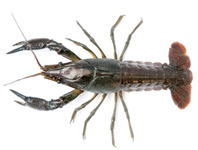Abstract
Chiropterotriton is a relatively small genus that comprises 15 species with great morphological and ecological diversity. In previous studies, molecular data provided evidence for a considerable number of species that remain undescribed. In this study, we describe one new species, Chiropterotriton chico sp. nov. based on molecular and morphological characters. We present mtDNA phylogenetic analyses using Bayesian inference and maximum likelihood that include all described and several undescribed species. Morphometric data from eight recognized species provide evidence for the distinctiveness of the new taxon. Description of this new species adds to the already high salamander diversity of the state of Hidalgo, which is an important area for the diversification of the genus.
References
Acevedo, A.A., Wake, D.B., Marquez, R. & Silva, K. (2013). Two new species of salamanders, genus Bolitoglossa (Amphibia: Plethodontidae). Zootaxa, 3609 (1), 69–84.
https://doi.org/10.11646/zootaxa.3609.1.5AmphibiaWeb (2017) Berkeley, California: AmphibiaWeb: Information on Amphibian Biology and Conservation [web application]. Available from: http://www.amphibiaweb.org (accessed 18 February 2017)
Boza-Oviedo, E., Rovito, S.M., Chaves, G., Garcia-Rodriguez, A., Artavia, L.G., Bolanos, F. & Wake, D.B. (2012) Salamanders from the eastern Cordillera de Talamanca, Costa Rica, with descriptions of five new species (Plethodontidae: Bolitoglossa, Nototriton, and Oedipina) and natural history notes from recent expeditions. Zootaxa, 3309, 36–61.
Campbell, J.A., Streicher, J.W., Cox, C.L. & Brodie, E.D. Jr. (2014) A new salamander of the genus Chiropterotriton (Caudata: Plethodontidae) from the Sierra Madre Oriental of Tamaulipas, Mexico. South American Journal of Herpetology, 9, 228–234.
https://doi.org/10.2994/SAJH-D-14-00042.1Cheng, T.L., Rovito, S.M., Wake, D.B. & Vredenburg, V.T. (2011) Coincident mass extirpation of neotropical amphibians with the emergence of the infectious fungal pathogen Batrachochytrium dendrobatidis. Proceedings of the National Academy Sciences, USA, 108, 9502–9507.
https://doi.org/10.1073/pnas.1105538108Darda, D.M. (1994) Allozyme variation and morphological evolution among Mexican salamanders of the genus Chiropterotriton (Caudata: Plethodontidae). Herpetologica, 50, 164–187.
Darda, D.M. & Wake, D.B. (2015) Osteological variation among extreme morphological forms in the Mexican salamander genus Chiropterotriton (Amphibia: Plethodontidae): Morphological evolution and homoplasy. PLoS ONE, 10 (6), 1–34.
https://doi.org/10.1371/journal.pone.0127248Darriba, D., Taboada, G.L., Doallo, R. & Posada, D. (2012) jModelTest 2: more models, new heuristics and parallel computing. Nature Methods, 9 (8), 772.
https://doi.org/10.1038/nmeth.2109Edgar, R.C. (2004) MUSCLE: a multiple sequence alignment method with reduced time and space complexity. BMC Bioinformatics, 5, 1–19.
https://doi.org/10.1186/1471-2105-5-113Flores-Villela, O. & Canseco-Márquez, L. (2004) Nuevas especies y cambios taxonómicos para la herpetofauna de México. Acta Zoológica Mexicana, New Series, 2, 115–144.
IUCN (2017) The IUCN Red List of Threatened Species. Version 2017-1. Available from: http://www.iucnredlist.org (accessed 7 August 2017)
Lemos-Espinal, J.A. & Smith, G.R. (2015) Amphibians and reptiles of the state of Hidalgo, Mexico. Checklist, 11, 1–11.
https://doi.org/10.15560/11.3.1642Luna, I., Morrone, J. & Espinosa, D. (2004) Biodiversidad de la Sierra Madre Oriental. Universidad Nacional Autónoma de México. México, D.F., 527 pp.
Luna, I., Morrone, J. & Espinosa, D. (2007) Biodiversidad de la Faja Volcánica Transmexicana. Universidad Nacional Autónoma de México. Universidad Nacional Autónoma de México, Facultad de Estudios Superiores Zaragoza e Instituto de Biología, México, D.F., 514 pp.
Lynch, J.F. & Wake, D.B. (1989) Two new species of Pseudoeurycea (Amphibia: Caudata) from Oaxaca, Mexico. Contributions in Science, Natural History Museum of Los Angeles County, 411, 11–22.
Maddison, W.P & Maddison, D.R (2015) Mesquite: a modular system for evolutionary analysis. Version 3.04. Available from: http://mesquiteproject.org (accessed 22 August 2017)
Miller, M.A., Pfeiffer, W. & Schwartz, T. (2010) Creating the CIPRES Science Gateway for inference of large phylogenetic trees. Proceedings of the Gateway Computing Environments Workshop (GCE), 2010, 1–8.
https://doi.org/10.1109/GCE.2010.5676129Parra-Olea, G. (2003) Phylogenetic relationships of the genus Chiropterotriton (Caudata: Plethodontidae) based on 16S ribosomal mtDNA. Canadian Journal of Zoology, 81, 2048–2060.
https://doi.org/10.1139/z03-155Parra-Olea, G., García-París, M. & Wake, D.B. (1999) Status of some populations of Mexican salamanders (Amphibia: Plethodontidae). Revista de Biología Tropical. San José, 47, 217–223.
Parra-Olea, G., Rovito, S. M., García-París, M., Maisano, J.A., Wake, D.B. & Hanken, J. (2016) Biology of tiny animals: three new species of minute salamanders (Plethodontidae: Thorius) from Oaxaca, Mexico. PeerJ, 4, e2694.
https://doi.org/10.7717/peerj.2694Rabb, G.B. (1958) On certain Mexican salamanders of the plethodontid genus Chiropterotriton. Occasional Papers of the Museum of Zoology, University of Michigan, 587, 1–37.
Ronquist, F., Teslenko, M., van der Mark, P., Ayres, D.L., Darling, A., Hohna, S., Larget, B., Liu, L., Suchard, M.A. & Huelsenbeck, J.P. (2012) MrBayes 3.2: efficient Bayesian phylogenetic inference and model choice across a large model space. Systematic Biology, 61, 539–542.
https://doi.org/10.1093/sysbio/sys029Rovito, S.M. & Parra-Olea, G. (2015) Two new species of Chiropterotriton (Caudata: Plethodontidae) from northern Mexico. Zootaxa, 4048 (1), 57–74.
https://doi.org/10.11646/zootaxa.4048.1.3Rovito, S.M., Parra-Olea, G., Recuero, E. & Wake, D.B. (2015) Diversification and biogeographical history of Neotropical plethodontid salamanders. Zoological Journal of the Linnean Society, 175, 167–188.
https://doi.org/10.1111/zoj.12271Stamatakis, A. (2006) RAxML-VI-HPC: Maximum likelihood-based phylogenetic analyses with thousands of taxa and mixed models. Bioinformatics, 22, 2688–2690.
https://doi.org/10.1093/bioinformatics/btl446Taylor, E.H. (1938) Concerning Mexican salamanders. The University of Kansas Science Bulletin, 25, 259–313.
https://doi.org/10.5962/bhl.part.1703Taylor, E.H. (1944) The genera of plethodont salamanders in Mexico. The University of Kansas Science Bulletin, 12, 189–232.
https://doi.org/10.5962/bhl.part.6508Townsend, J.H., Butler, J.M., Wilson, L.D. & Austin, J.D. (2010) A distinctive new species of moss salamander (Caudata: Plethodontidae: Nototriton) from an imperiled Honduran endemism hotspot. Zootaxa, 2434, 1–16.
Wake, D.B. (2012) Taxonomy of salamanders of the family Plethodontidae (Amphibia: Caudata). Zootaxa, 3484, 75–82.
Wake, D.B. & Elias, P. (1983) New genera and a new species of Central American salamanders, with a review of tropical genera (Amphibia, Caudata, Plethodontidae). Contributions in Science, Natural History Museum of Los Angeles County, 345, 1-–19.
Wake, D.B. & Lynch, J.F. (1976) The distribution, ecology and evolutionary history of plethodontid salamanders in tropical America. Bulletin of the Natural History Museum of Los Angeles County, 25, 1–65.
Woodall, H.T. (1941) A new Mexican salamander of the genus Oedipus. Occasional Papers of the Museum of Zoology, University of Michigan, 444, 1–4.

